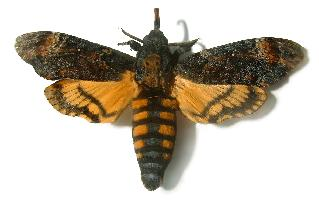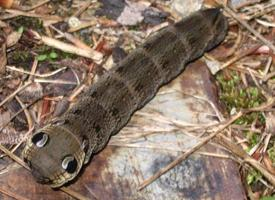
Váhy a míry
| Rychlost | 40 km/h |
|---|---|
| Délka rozpětí křídel | 13 cm |
Popis zvířete
The African death's-head hawkmoth, scientifically known as Acherontia atropos, is a remarkable and enigmatic species of moth that belongs to the family Sphingidae. This species is one of the three species in the genus Acherontia, and it is perhaps the most widely recognized due to its distinctive appearance and fascinating behaviors. Acherontia atropos is distributed across the warmer regions of Africa, though its range extends through Europe and into parts of Asia, showcasing its adaptability to various environments.One of the most striking features of the African death's-head hawkmoth is its size. With a wingspan reaching up to 13 centimeters (over 5 inches), it is one of the larger moth species. Its body is robust and heavy, allowing it to undertake long migratory journeys. The moth's coloration is predominantly a mix of dark brown and yellow hues, with intricate patterns that provide excellent camouflage against bark and leaves. However, what truly sets this moth apart is the skull-like pattern located on the thorax. This eerie marking has been the source of much fascination and superstition, contributing to the moth's ominous name.
The forewings of Acherontia atropos are dark with intricate patterns that blend into the night, while the hindwings are brighter, with shades of yellow and orange, marked by bold, black bands. This coloration not only serves as camouflage but also as a warning to potential predators about the moth's unpalatability.
Acherontia atropos exhibits some unique behaviors. One of the most notable is its ability to produce a loud, squeaking noise when agitated or handled. This sound is produced by forcefully expelling air from its proboscis, a feature that is quite rare among moths and butterflies. Additionally, the moth has a notorious penchant for raiding beehives to feed on honey. It is remarkably adapted to this risky behavior; it can mask its scent to blend in with the bees and is even able to produce sounds that mimic those of a queen bee, thus reducing its chances of being attacked by the hive's inhabitants.
The lifecycle of the African death's-head hawkmoth follows a typical pattern for moths, with the female laying eggs that hatch into larvae. The caterpillars are large and can be found in a variety of colors, including green, yellow, and brown, with lateral stripes running along their bodies. They feed on a wide range of host plants, including potato, jasmine, and oleander, which contributes to their survival in diverse environments. After a period of feeding and growth, the caterpillar pupates, undergoing a remarkable transformation into the adult moth.
Despite its somewhat grim name and appearance, Acherontia atropos plays a vital role in its ecosystem, particularly as a pollinator and as part of the food chain. Its presence across various habitats underscores its adaptability and the intricate balance of nature. The African death's-head hawkmoth remains a subject of scientific interest and cultural fascination, symbolizing the beauty and mystery of the natural world.
Podobná zvířata
Nové fotografie zvířat
Top 10 zvířat
- Chinese water dragon (Physignathus cocincinus)
- Galápagos tortoise (Geochelone nigra complex)
- Dolphin gull (Leucophaeus scoresbii)
- Japanese macaque (Macaca fuscata)
- Colombian red howler (Alouatta seniculus)
- Sea urchins (Echinoidea)
- Diana monkey (Cercopithecus diana)
- Moustached guenon (Cercopithecus cephus)
- Colossal squid (Mesonychoteuthis hamiltoni)
- Common house mosquito (Culex pipiens)
